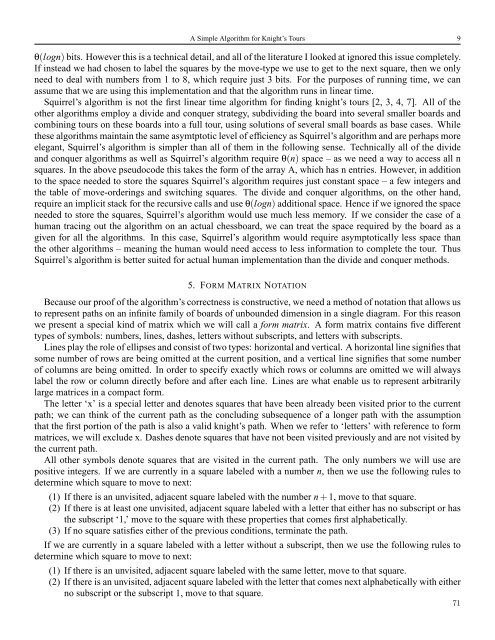A SIMPLE ALGORITHM FOR KNIGHT'S TOURS Chess is a two ...
A SIMPLE ALGORITHM FOR KNIGHT'S TOURS Chess is a two ...
A SIMPLE ALGORITHM FOR KNIGHT'S TOURS Chess is a two ...
Create successful ePaper yourself
Turn your PDF publications into a flip-book with our unique Google optimized e-Paper software.
A Simple Algorithm for Knight’s Tours 9θ(logn) bits. However th<strong>is</strong> <strong>is</strong> a technical detail, and all of the literature I looked at ignored th<strong>is</strong> <strong>is</strong>sue completely.If instead we had chosen to label the squares by the move-type we use to get to the next square, then we onlyneed to deal with numbers from 1 to 8, which require just 3 bits. For the purposes of running time, we canassume that we are using th<strong>is</strong> implementation and that the algorithm runs in linear time.Squirrel’s algorithm <strong>is</strong> not the first linear time algorithm for finding knight’s tours [2, 3, 4, 7]. All of theother algorithms employ a divide and conquer strategy, subdividing the board into several smaller boards andcombining tours on these boards into a full tour, using solutions of several small boards as base cases. Whilethese algorithms maintain the same asymtptotic level of efficiency as Squirrel’s algorithm and are perhaps moreelegant, Squirrel’s algorithm <strong>is</strong> simpler than all of them in the following sense. Technically all of the divideand conquer algorithms as well as Squirrel’s algorithm require θ(n) space – as we need a way to access all nsquares. In the above pseudocode th<strong>is</strong> takes the form of the array A, which has n entries. However, in additionto the space needed to store the squares Squirrel’s algorithm requires just constant space – a few integers andthe table of move-orderings and switching squares. The divide and conquer algorithms, on the other hand,require an implicit stack for the recursive calls and use θ(logn) additional space. Hence if we ignored the spaceneeded to store the squares, Squirrel’s algorithm would use much less memory. If we consider the case of ahuman tracing out the algorithm on an actual chessboard, we can treat the space required by the board as agiven for all the algorithms. In th<strong>is</strong> case, Squirrel’s algorithm would require asymptotically less space thanthe other algorithms – meaning the human would need access to less information to complete the tour. ThusSquirrel’s algorithm <strong>is</strong> better suited for actual human implementation than the divide and conquer methods.5. <strong>FOR</strong>M MATRIX NOTATIONBecause our proof of the algorithm’s correctness <strong>is</strong> constructive, we need a method of notation that allows usto represent paths on an infinite family of boards of unbounded dimension in a single diagram. For th<strong>is</strong> reasonwe present a special kind of matrix which we will call a form matrix. A form matrix contains five differenttypes of symbols: numbers, lines, dashes, letters without subscripts, and letters with subscripts.Lines play the role of ellipses and cons<strong>is</strong>t of <strong>two</strong> types: horizontal and vertical. A horizontal line signifies thatsome number of rows are being omitted at the current position, and a vertical line signifies that some numberof columns are being omitted. In order to specify exactly which rows or columns are omitted we will alwayslabel the row or column directly before and after each line. Lines are what enable us to represent arbitrarilylarge matrices in a compact form.The letter ‘x’ <strong>is</strong> a special letter and denotes squares that have been already been v<strong>is</strong>ited prior to the currentpath; we can think of the current path as the concluding subsequence of a longer path with the assumptionthat the first portion of the path <strong>is</strong> also a valid knight’s path. When we refer to ‘letters’ with reference to formmatrices, we will exclude x. Dashes denote squares that have not been v<strong>is</strong>ited previously and are not v<strong>is</strong>ited bythe current path.All other symbols denote squares that are v<strong>is</strong>ited in the current path. The only numbers we will use arepositive integers. If we are currently in a square labeled with a number n, then we use the following rules todetermine which square to move to next:(1) If there <strong>is</strong> an unv<strong>is</strong>ited, adjacent square labeled with the number n + 1, move to that square.(2) If there <strong>is</strong> at least one unv<strong>is</strong>ited, adjacent square labeled with a letter that either has no subscript or hasthe subscript ‘1,’ move to the square with these properties that comes first alphabetically.(3) If no square sat<strong>is</strong>fies either of the previous conditions, terminate the path.If we are currently in a square labeled with a letter without a subscript, then we use the following rules todetermine which square to move to next:(1) If there <strong>is</strong> an unv<strong>is</strong>ited, adjacent square labeled with the same letter, move to that square.(2) If there <strong>is</strong> an unv<strong>is</strong>ited, adjacent square labeled with the letter that comes next alphabetically with eitherno subscript or the subscript 1, move to that square.71
















